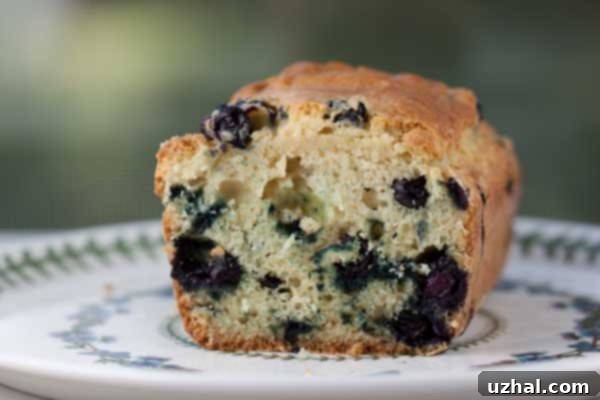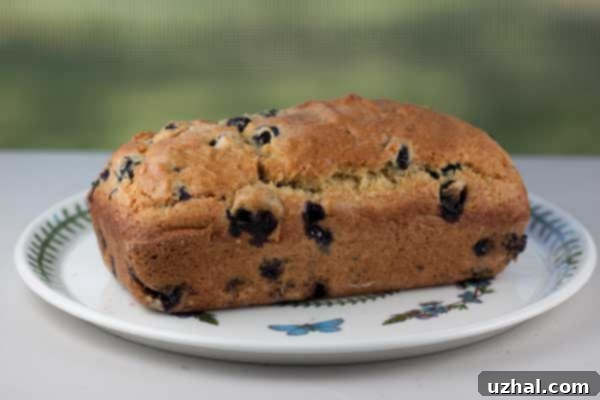The Ultimate Recipe for Moist & Flavorful Fresh Blueberry Bread
There’s nothing quite like the comforting aroma of freshly baked goods filling your home, and this Fresh Blueberry Bread recipe delivers just that. Often described as the less sweet, more substantial cousin to a Blueberry Sour Cream Loaf Cake, this quick bread offers a unique profile that’s both satisfying and utterly delicious. It stands out by being intentionally less sweet, allowing the natural tang and sweetness of the blueberries to truly shine through. Instead of butter, we opt for oil, which results in a distinctively moist and tender crumb, characteristic of a classic quick bread – a bit heavier than a cake, but wonderfully rich in moisture.
This recipe is designed for ease and enjoyment, perfect for a delightful breakfast, a satisfying snack with your afternoon coffee, or even a light dessert. Whether you’re an experienced baker or just starting out, you’ll find this blueberry bread straightforward to prepare and immensely rewarding to share (or keep all to yourself!). Get ready to indulge in a slice of pure comfort, studded with juicy, bursting blueberries.
Embracing the Quick Bread Difference: Oil vs. Butter
One of the defining characteristics of this Fresh Blueberry Bread is its use of oil instead of butter. This choice isn’t just a matter of preference; it significantly impacts the bread’s texture and moisture. While butter contributes a rich flavor and a denser, often more crumbly texture to baked goods like pound cakes or biscuits, oil tends to create a lighter, more consistently moist crumb. This is because oil remains liquid at room temperature, incorporating more easily into the batter and preventing the gluten in the flour from developing too much, which can lead to a tough bread.
When you use vegetable oil, such as grapeseed oil (as mentioned in the original recipe), canola oil, or even a light olive oil, you’re ensuring that your blueberry bread will be incredibly tender and moist, staying fresh longer than many butter-based recipes. The neutral flavor of most vegetable oils also means that the vibrant taste of the blueberries and vanilla can truly shine, unobstructed by the dairy notes of butter. This method is ideal for quick breads, where a tender, soft texture is paramount.
Choosing Your Sweetener: Options for Every Preference
The original recipe highlighted the use of Ideal Sweetener, an alternative to traditional sugar. This demonstrates the versatility of this Fresh Blueberry Bread recipe, making it suitable for those looking to reduce their sugar intake or explore different dietary options. If you’re seeking an alternative sweetener, Ideal Sweetener or similar products can work exceptionally well, providing sweetness without compromising the bread’s texture.
However, the beauty of baking lies in customization. If you prefer to use traditional granulated sugar, feel free to do so. The “less sweet” profile simply means it’s not overly saccharine, allowing the natural fruit flavors to take center stage. For those experimenting with other artificial sweeteners like Stevia, Erythritol, or Monk Fruit, be sure to consult the product’s conversion chart to achieve the desired level of sweetness. Remember that some artificial sweeteners can behave differently in baking, affecting browning or moisture, so a bit of experimentation might be needed to find your perfect balance. Regardless of your choice, the core principle remains: a delicious bread where the blueberries are the star, supported by a gentle sweetness.
The Critical Role of Pan Size in Baking Success
Achieving the perfect bake for your Fresh Blueberry Bread heavily relies on using the correct pan size. This recipe specifically calls for an 8×4 inch loaf pan, which is a bit smaller than what is typically found in most modern kitchens. Standard loaf pans these days often measure 8.5 by 4.5 inches or even 9 by 5 inches. This distinction is crucial because pan size directly influences baking time, the height of your loaf, and its internal texture.
Understanding Pan Dimensions and Their Impact
- 8×4 Inch Loaf Pan: This size typically holds about 4 cups of batter. Using this pan will yield a taller, denser loaf that takes longer to bake through, ensuring a wonderfully moist interior and a beautifully browned crust.
- Larger Loaf Pans (e.g., 8.5×4.5 or 9×5 inches): If you use a larger pan, your batter will spread out more, resulting in a shorter loaf. Consequently, the baking time will likely be shorter because the heat penetrates the thinner batter more quickly. You’ll need to monitor the bread closely to prevent it from becoming dry.
Tips for Adjusting Bake Time
Should you use a different sized pan, here are some tips to ensure your bread bakes perfectly:
- Monitor Closely: Start checking for doneness about 10-15 minutes earlier than the recommended time if using a larger pan. For a smaller pan, you might need an extra 5-10 minutes.
- Toothpick Test: The classic test remains the most reliable. Insert a toothpick into the center of the loaf. If it comes out clean or with a few moist crumbs (but no wet batter), your bread is ready.
- Visual Cues: Look for a golden-brown crust and edges that pull away slightly from the sides of the pan.
While an 8×4 inch loaf pan might require a quick search (the one originally linked might be out of stock, but serves as a great reference for the size), investing in one or adjusting your baking strategy for a different pan will ensure your Fresh Blueberry Bread turns out beautifully every time. The right pan is key to achieving that ideal balance of a moist interior and a perfectly golden crust.
- Quick Butterscotch Cream Pie or “Pick Your Flavor” Pie
- Fresh Blueberry Muffins
- Honey Maple Chocolate Chip Cookies
- Blueberry Oatmeal Cookies
- Caramel Flavored Sweetened Condensed Milk
Fresh Blueberry Bread Recipe

Fresh Blueberry Bread
Cookie Madness
Pin Recipe
Ingredients
- 2 large eggs: Crucial for structure and moisture.
- ⅔ cup sugar or equivalent artificial sweetener: Provides sweetness and helps with browning. Adjust to your taste, or use your preferred sugar substitute.
- ⅓ cup vegetable oil I used grapeseed, but canola or a neutral-flavored oil works well: Key for that distinctively moist and tender quick bread texture.
- ¼ cup whole milk: Adds richness and moisture, contributing to the soft crumb.
- 1 ½ teaspoons vanilla extract: Enhances overall flavor, complementing the blueberries.
- 1 ½ cups all-purpose flour 7 oz/200 grams, spooned and leveled for accuracy: The base for the bread’s structure. Proper measuring prevents a dense loaf.
- ½ teaspoon baking soda: A leavening agent that reacts with acidic ingredients (like blueberries as they cook, and any slight acidity in milk/sweetener) to create lift.
- 1 teaspoon baking powder: Another leavening agent that works with baking soda to give the bread its rise and fluffy texture.
- ¼ teaspoon salt: Balances the sweetness and enhances all the flavors. Don’t skip it!
- 1 heaping cup fresh blueberries: The star of the show! Use fresh for the best texture and flavor, or properly drained frozen blueberries.
Instructions
-
Prepare Your Pan and Oven: Preheat your oven to 350 degrees F (175 degrees C). This ensures the oven is at the correct temperature when the bread goes in, allowing for an even rise. Lightly grease an 8×4 inch loaf pan (with approximately 4 cup capacity). For easy removal and cleanup, line the pan with parchment paper, leaving an overhang on the short sides to create “handles.” This simple step makes lifting the baked loaf out a breeze.
-
Combine Wet Ingredients: In a large mixing bowl, whisk together the eggs, sweetener (sugar or alternative), vegetable oil, whole milk, and vanilla extract until they are well combined and smooth. This creates the liquid base for your bread.
-
Mix Dry Ingredients & Integrate: In a separate, medium-sized bowl, combine the all-purpose flour, baking powder, baking soda, and salt. Stir these dry ingredients together thoroughly to ensure the leavening agents are evenly distributed. Gradually add the dry mixture to the wet mixture, stirring gently until just combined. Be careful not to overmix; overmixing can develop the gluten too much, leading to a tough bread. Finally, very carefully fold in the fresh blueberries. If using frozen blueberries, do not thaw them first, and toss them with a tablespoon of flour before adding to prevent them from sinking to the bottom.
-
Bake and Cool: Pour the batter evenly into your prepared loaf pan. Bake on the center rack of your preheated oven for approximately 40-45 minutes. The exact baking time can vary depending on your oven and pan size, so check for doneness by inserting a toothpick into the center of the loaf; it should come out clean or with moist crumbs attached. Once baked, let the bread cool in the pan for about 30 minutes. This allows the loaf to set and prevents it from crumbling. After this initial cooling, carefully lift the bread out using the parchment paper handles and transfer it to a wire rack to cool completely for several hours before slicing. Slicing too early can result in a gummy texture.
Notes & Pro Tips
Serving Suggestions & Variations
This Fresh Blueberry Bread is perfect on its own, but you can elevate the experience with a few simple additions. Enjoy a slice with your morning coffee or tea, perhaps alongside a dollop of Greek yogurt for a wholesome breakfast. For an afternoon treat, it pairs beautifully with a light spread of cream cheese or a sprinkle of powdered sugar for a touch of elegance.
Creative Variations:
- Lemon Zest: Add 1-2 teaspoons of lemon zest to the wet ingredients for a bright, citrusy counterpoint to the blueberries. Lemon and blueberry are a classic pairing!
- Nutty Crunch: Fold in ½ cup of chopped walnuts or pecans with the blueberries for added texture and a nutty flavor.
- Streusel Topping: For an extra layer of sweetness and crunch, prepare a simple streusel topping: combine ¼ cup flour, 2 tablespoons sugar, and 1 tablespoon cold butter (cut into small pieces). Mix with your fingertips until crumbly, then sprinkle over the batter before baking.
- Glaze It: A simple lemon glaze (powdered sugar mixed with a touch of lemon juice) drizzled over the cooled loaf adds a lovely finish and an extra zing.
Storage Tips for Maximum Freshness
To keep your Fresh Blueberry Bread moist and delicious for as long as possible, proper storage is key.
- Room Temperature: Store the cooled loaf tightly wrapped in plastic wrap or in an airtight container at room temperature for up to 3-4 days. The oil in the recipe helps to retain moisture, ensuring it stays fresh longer.
- Refrigeration: While not strictly necessary, if you live in a humid climate or want to extend its shelf life, you can refrigerate the bread for up to a week. Make sure it’s well-wrapped to prevent it from drying out.
- Freezing: This blueberry bread freezes exceptionally well! Once completely cooled, wrap the entire loaf or individual slices tightly in plastic wrap, then place in a freezer-safe bag or aluminum foil. It can be frozen for up to 2-3 months. Thaw at room temperature or gently warm individual slices in the microwave or oven.
Enjoying a homemade loaf of Fresh Blueberry Bread is a simple pleasure that brings warmth and flavor to any day. With these tips and the detailed recipe, you’re well on your way to baking a perfect loaf every time.
